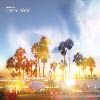 Munk's fascinationwith all things tropical or celestial has not diminished, as Manual'smusic captures the sound of laying out on the beach in your best swimtrunks and Def Leppard cut-off shirt. Songs are saturated with the samesynthesized sound which drenched the 1980s new wave pop movement. Munk,however is careful to add his own unique fringes of electronic eddiesand whirlpools to the music. He is infatuated with the way stars soundif they fell to earth and danced gently on the ocean. "Summer ofFreedom" has a measured and thumping prelude (replete with clappingsounds) to the ultimate supernova of exploded synthesizers which thenebbs back into the prelude theme only to explode once again. There areabout four catharses in this 11-minute song alone and they all feelreally good. The third quarter of the song devolves into a more quietand ruminative state before gathering up its strength for one lastcelebration by the end. There are two classes of songs here: thosewhich are paced and progress ("Summer of Freedom" and "Neon Reverie")and others which simply swirl atmospherically and go nowhere("Tourmaline" and "Azure Vista"). I find the progressive songs moreinteresting and I get lost amidst the cosmic dust of the swirling ones."Clear Skies Above the Coastline Cathedral" spans both types of songs.On the one hand, the melody is fairly static and there is not muchdevelopment in the themes. On the other hand, a handful of other soundsdance around the leitmotif and it builds and swells along with theseinstruments. So there is a progression, yet is always tethered to acentral locus. Also, there is the obligatory sound of ocean waves atthe beginning. Azure Vista would make a properly complementary soundtrack to a sentimental 1980s film like the estimable Andrew McCarthy romp Mannequin,if that film were set on the beach and excised that horrid Starshipsong from the credit titles. Actually, perhaps McCarthy's Weekend at Bernie's(with its appropriate beach setting) could be used to make an amalgamof the two and then add Manual's music as the score. The delightful"Neon Reverie" would make a particularly inspired choice for an endscene fade-out. Additionally, the album's cover is indicative of thesound. A double-exposed beachfront Californian dusk with saffron lightsmixing with azure skies, all impacted by darkly-jutting palm trees. Itlooks particularly lush and candy-colored, just as the music can beboth sweet and ephemeral, unable to stick to the roof of your mouth forvery long. Musically and visually, this album is the cotton candy ofManual releases.
Munk's fascinationwith all things tropical or celestial has not diminished, as Manual'smusic captures the sound of laying out on the beach in your best swimtrunks and Def Leppard cut-off shirt. Songs are saturated with the samesynthesized sound which drenched the 1980s new wave pop movement. Munk,however is careful to add his own unique fringes of electronic eddiesand whirlpools to the music. He is infatuated with the way stars soundif they fell to earth and danced gently on the ocean. "Summer ofFreedom" has a measured and thumping prelude (replete with clappingsounds) to the ultimate supernova of exploded synthesizers which thenebbs back into the prelude theme only to explode once again. There areabout four catharses in this 11-minute song alone and they all feelreally good. The third quarter of the song devolves into a more quietand ruminative state before gathering up its strength for one lastcelebration by the end. There are two classes of songs here: thosewhich are paced and progress ("Summer of Freedom" and "Neon Reverie")and others which simply swirl atmospherically and go nowhere("Tourmaline" and "Azure Vista"). I find the progressive songs moreinteresting and I get lost amidst the cosmic dust of the swirling ones."Clear Skies Above the Coastline Cathedral" spans both types of songs.On the one hand, the melody is fairly static and there is not muchdevelopment in the themes. On the other hand, a handful of other soundsdance around the leitmotif and it builds and swells along with theseinstruments. So there is a progression, yet is always tethered to acentral locus. Also, there is the obligatory sound of ocean waves atthe beginning. Azure Vista would make a properly complementary soundtrack to a sentimental 1980s film like the estimable Andrew McCarthy romp Mannequin,if that film were set on the beach and excised that horrid Starshipsong from the credit titles. Actually, perhaps McCarthy's Weekend at Bernie's(with its appropriate beach setting) could be used to make an amalgamof the two and then add Manual's music as the score. The delightful"Neon Reverie" would make a particularly inspired choice for an endscene fade-out. Additionally, the album's cover is indicative of thesound. A double-exposed beachfront Californian dusk with saffron lightsmixing with azure skies, all impacted by darkly-jutting palm trees. Itlooks particularly lush and candy-colored, just as the music can beboth sweet and ephemeral, unable to stick to the roof of your mouth forvery long. Musically and visually, this album is the cotton candy ofManual releases.samples:
Read More

